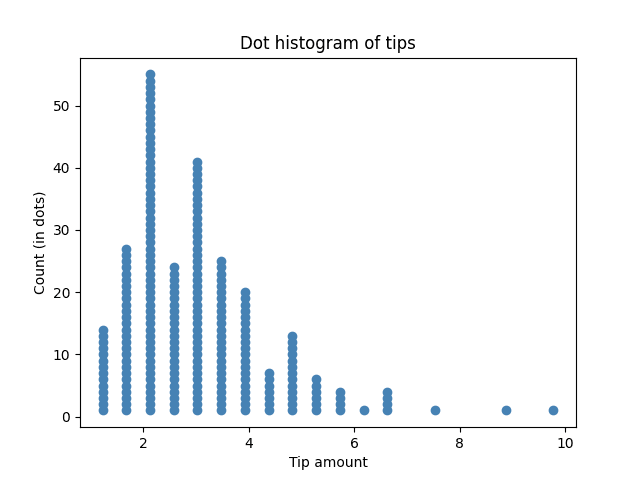Create informative dot plots to visualize the distribution of your data points. Upload your own data or try our sample datasets.
Try it out!
- Click Sample Data and select Iris Dataset
- For Data column, select sepal_length
- For Color column, select species to color points by species
- Leave Binning Method as Auto for optimal binning
- Enable Show Mean and Show Median to visualize key statistics if no color grouping is selected
- Click Generate Dot Plot to visualize the data
Calculator
1. Load Your Data
2. Select Columns & Options
Binning Options
Auto mode uses the Freedman-Diaconis rule to automatically determine the optimal number of bins based on your data's distribution and sample size.
Related Calculators
Learn More
What is a Dot Plot?
A dot plot is a statistical chart that displays data points as dots positioned along an axis. Each dot represents a single data point, making it an excellent visualization for showing the distribution of values in a dataset. Dot plots are particularly useful when dealing with smaller datasets, as they preserve the visibility of individual data points.
Interpreting Dot Plots
When interpreting a dot plot, consider the following:
- Shape of the distribution (symmetrical, skewed, bimodal, etc.)
- Density of points (where data points are concentrated)
- Spread of the data (range and variation)
- Presence of outliers or unusual patterns
- Comparison between different groups if present
Dot Plots vs. Other Visualizations
Dot plots offer several advantages over similar chart types:
- Unlike histograms, dot plots preserve individual data points
- Compared to box plots, dot plots show the actual distribution rather than just summary statistics
- Dot plots work particularly well for small to medium-sized datasets where seeing individual points matters
- Adding jitter to a dot plot helps visualize overlapping points, revealing the true density of data
How to create dot plots in R
The ggplot2 package provides the geom_dotplot() function.
library(tidyverse)
tips <- read.csv("https://raw.githubusercontent.com/plotly/datasets/master/tips.csv")
# use default binning
ggplot(tips, aes(x = tip)) +
geom_dotplot() +
theme_minimal()
# specify binwidth since some bin contains too many points
ggplot(tips, aes(x = tip)) +
geom_dotplot(binpositions = "all", binwidth = 0.2) +
theme_minimal()
# if you don't want to see the y ticks
ggplot(tips, aes(x = tip)) +
geom_dotplot(binpositions = "all", binwidth = 0.2) +
theme_minimal() +
theme(axis.ticks.y = element_blank(), axis.text.y = element_blank())
How to create dot plots in Python
While Python's popular libraries like Matplotlib and Seaborn do not have a dedicated dot plot function, you can create dot plots using scatter plots or by stacking points vertically. Here's an example using Matplotlib:
import numpy as np
tips = pd.read_csv("https://raw.githubusercontent.com/plotly/datasets/master/tips.csv")
x = tips["tip"]
counts, bins = np.histogram(x, bins=20)
for i, count in enumerate(counts):
for j in range(count):
plt.plot(bins[i] + (bins[i+1]-bins[i])/2, j+1, "o", color="steelblue")
plt.xlabel("Tip amount")
plt.ylabel("Count (in dots)")
plt.title("Dot histogram of tips")
plt.show()